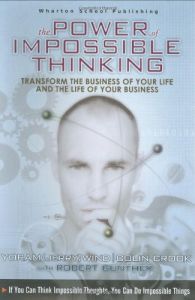Join getAbstract to access the summary!

Join getAbstract to access the summary!
Colin Crook, Yoram (Jerry) Wind and Robert Gunther
The Power of Impossible Thinking
Transform the Business of Your Life and the Life of Your Business
Wharton School Publishing, 2005
What's inside?
If you get locked in an old mental model, you may miss the reality of new circumstances. Be ready to shift your thinking.
Recommendation
This book provides an elementary introduction to the way the mind works, but it is an entirely practical introduction. Authors Yoram (Jerry) Wind and Colin Crook tell readers the basics of mental functioning in order to warn them about putting too much trust in what seems to be. What we see is, in fact, not reality but rather mental models that we ourselves construct. When we understand this, we begin to see why it is important to test our mental models continuously for relevance to reality, and to change them. The authors address the impact of mental models on everything from business to personal health, using strong case histories (such as Oprah Winfrey’s life changing story) as illustrations. As a lagniappe, the publisher includes a CD with a brief summary of the book’s main points. getAbstract recommends this straightforward exposition; it will help you think about how you think.
Summary
About the Authors
Yoram (Jerry) Wind is a professor of marketing, Lauder Professor and Founding Director of the Wharton Fellows Program and the SEI Center for Advanced Studies in Management at the Wharton School of the University of Pennsylvania. He wrote Convergence Marketing and Driving Change. Colin Crook, a senior fellow at Wharton, is a member of the Rein Capital advisory board and the Emergence journal’s editorial board.

















Comment on this summary